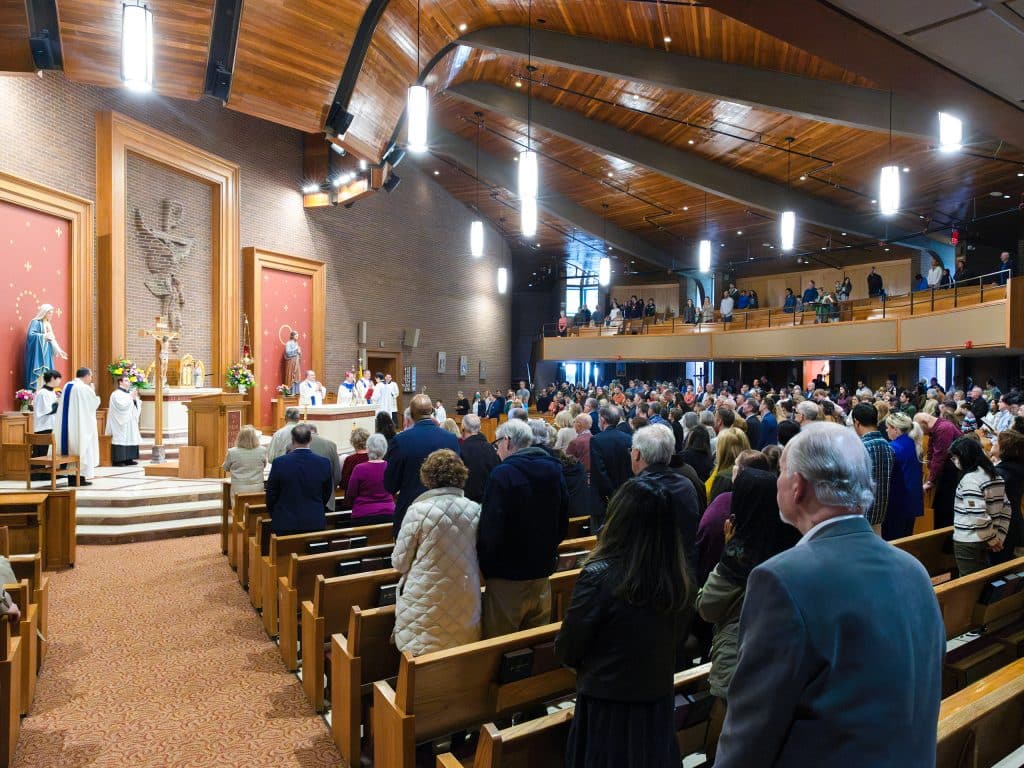“Amen, amen, I say to you, no one can enter the kingdom of God without being born of water and Spirit” (Jn 3:5). “Go, therefore, and make disciples of all nations, baptizing them in the name of the Father, and of the Son, and of the Holy Spirit, teaching them to observe all that I have commanded you. And behold, I am with you always, until the end of the age” (Mt 28:19-20).
In these two verses from sacred Scripture, the Church finds the foundation for Her teaching that baptism is necessary for salvation. As the Catechism of the Catholic Church (CCC) states, “The Church does not know of any means other than Baptism that assures entry into eternal beatitude; this is why she takes care not to neglect the mission she has received from the Lord to see that all who can be baptized are ‘reborn of water and the Spirit.'” (CCC 1257). Because baptism is “the basis of the whole Christian life, the gateway to life in the Spirit, and the door which gives access to the other sacraments” (CCC 1213), the Church has reminded Christian parents of their obligation to have their children baptized shortly after birth (Code of Canon Law, Canon 867, §1), and, in the case of unbaptized adults, has fully initiated them into the life of the Church by conferring upon them the sacraments of baptism, confirmation and the holy Eucharist.
Normally, baptism is administered in a church or oratory (in the case of a child, this would usually be the parish church of the parents) by a bishop, priest or deacon. In the Latin-rite Church, these are the ordinary ministers of baptism. However, there can be cases of urgent necessity in which a lay person can conduct an “emergency baptism.” The Rite of Baptism makes it clear, though, that such “emergency baptisms” are licit only in very limited circumstances, such as when a person is in danger of death. “In imminent danger of death and especially at the moment of death, when no priest or deacon is available, any member of the faithful, indeed anyone with the right intention, may and sometimes must administer baptism” (Rite of Baptism, No. 16).
The Dec. 10-16, 2009, issue of the Catholic Herald carried a story on page 3 that could potentially create misunderstandings and confusion among the faithful as to the proper circumstances in which a lay person can baptize. These proper circumstances, according to the laws of the Church, are limited to either the danger of death (as noted above) or to a situation wherein a priest or deacon is absent or impeded from administering the sacrament (this might be the case, for example, in mission territories where there is a scarcity of priests or deacons). In the Catholic Herald story, it appears that the children who were baptized by their grandfather were not in danger of death, and it did not appear that a priest was impeded from celebrating the sacrament. Therefore, a reader might be confused as to whether the conditions under which a lay person could baptize were present, and whether the baptisms, although valid if performed correctly, might have been illicit. In sacramental theology, the term “valid” refers to the essence of a sacrament: what makes a sacrament to be a sacrament. In the case of baptism, validity means that the minister used the correct matter and form: that is, water (the matter of baptism) and the Trinitarian formula. The term “licit” refers to what Church law prescribes concerning the administration of the sacraments.
The Catholic Herald story further stated that the pastor of the grandfather’s parish would not baptize the grandchildren because “the parents would have to agree to raise the children as Catholic,” but the grandfather “could do it and it would be as valid as if the pope had performed the baptism” (Catholic Herald, “From Pressroom to Newsroom”). As written, such statements are misleading. First, the Code of Canon Law is clear that only in danger of death may a child be licitly baptized against the will of the parents (Canon 868, §2). Second, in order for a child not in danger of death to be baptized licitly, one or both of the parents (or a guardian) must consent, and there must be a founded hope that the child will be brought up in the Catholic Faith (cf. Canon 868, §1, 1º, 2º). Third, once the children’s grandfather had baptized them, those children were incorporated into Christ and became members of His Mystical Body, the Church (cf. canon 849), and bound to observe the Church’s life, teachings and discipline – just as they would have been had a priest or deacon baptized them.
Some might wonder why the Church has such rules specifying that a lay person can administer baptism only in a few limited circumstances. The reason is simple: because of the importance of baptism, both sacramentally and juridically, the Church wants to ensure that everyone who desires to be baptized (either personally, if an adult, or through their parents or guardians, if a child) receives the sacrament validly, with the proper matter and form, and that the conferral of the sacrament is properly recorded. The proper recording of sacramental reception is important so that there can be objective proof that a person was baptized and thus capable of receiving the other sacraments.
Baptism not only cleanses a person from sin (both original sin and any actual sins the person may have committed) and makes that person an adopted son or daughter of God; the sacrament also confers upon the one baptized a new status as a member of Christ’s faithful, the Church. Therefore, the Church has always taken care to ensure that the sacrament of baptism is properly administered so that those who are baptized can begin to live the Christian life, sharing in all the rights and fulfilling all the obligations that come with being a disciple of Jesus Christ.
How to baptize in case of danger of death
The Rite of Baptism says, “All lay persons, since they belong to the priestly people, and especially parents and, by reason of their work, catechists, obstetricians, … nurses of the sick, as well as physicians and surgeons, should know the proper method of baptizing in cases of necessity” (Rite of Baptism, 17).
In the case of necessity (e.g., the danger of death), the person who baptizes pours water three times over the candidate’s head, or immerses the candidate three times in water, while simultaneously pronouncing the baptismal formula: “N., I baptize you in the name of the Father (the minster pours water or immerses the first time), and of the Son (the minister pours water or immerses a second time), and of the Holy Spirit (the minister pours water or immerses a third time).” A lay person who administers an emergency baptism must at least have the intention to do what the Church does when baptizing. It is also desirable that, as far as possible, one or two witnesses to the baptism be present.
When baptism has been administered neither by the pastor nor in his presence, the minister of the baptism, whoever that was, must inform the pastor of the parish in whose territory the baptism occured, so that the pastor may record it in accord with canon 877, §1.


